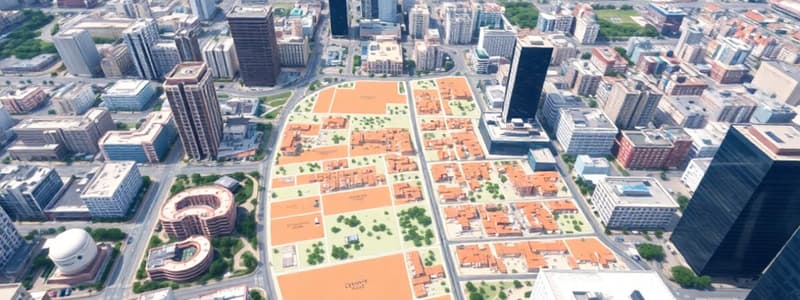Podcast
Questions and Answers
What happens to land value as the distance from the Primary Value Index (PVI) increases?
What happens to land value as the distance from the Primary Value Index (PVI) increases?
- Land value remains constant.
- Land value increases significantly.
- Land value decreases. (correct)
- Land value fluctuates unpredictably.
Which of the following describes a role of the Central Business District (CBD)?
Which of the following describes a role of the Central Business District (CBD)?
- Predominantly residential housing.
- Agricultural center for the city.
- Central market place and entertainment hub. (correct)
- Primarily consists of single-family homes.
Which statement correctly reflects the pattern of residential users in relation to the CBD?
Which statement correctly reflects the pattern of residential users in relation to the CBD?
- Residential areas near the CBD are exclusively single-family homes.
- Wealthier households often reside in the CBD.
- Poorer households are often located further from the CBD.
- The density of residential units is highest closest to the CBD. (correct)
During which historical period did the increase in mobility lead to the creation of a Central Business District (CBD)?
During which historical period did the increase in mobility lead to the creation of a Central Business District (CBD)?
What is the significance of the concept of land value and bid rent in urban expansion?
What is the significance of the concept of land value and bid rent in urban expansion?
What primary factor determines the way land is used in urban areas?
What primary factor determines the way land is used in urban areas?
Which urban function is characterized by the exchange of goods and services?
Which urban function is characterized by the exchange of goods and services?
What does the prime-value intersection (PVI) indicate in a city?
What does the prime-value intersection (PVI) indicate in a city?
In terms of urban functions, how does access to the PVI primarily influence land value?
In terms of urban functions, how does access to the PVI primarily influence land value?
How does the concept of bid rent relate to land-use in urban settings?
How does the concept of bid rent relate to land-use in urban settings?
Flashcards are hidden until you start studying
Study Notes
Urban Functions and Land-Use Distribution
- Urban functions are the features present in a city, including retail, industrial, commercial, residential, public space, and educational.
- The distribution of these functions is influenced by land value and bid rent, which are determined by market forces.
- Land value and bid rent dictate how land is used and how much it costs.
- Highly valued land tends to have more intensive land uses, while cheaper land may have less intensive uses.
- The "site" and "internal situation" are significant factors in determining land value.
The Central Business District (CBD)
- The prominent landmark of a city with high central importance for a variety of activities.
- The CBD is often located at transportation breaks, simplifying the movement of goods.
- It acts as a central market, entertainment hub, transportation node, administrative center, and corporate office district.
- The CBD typically has the highest land value due to its central location and intensive land use.
- This results in high density, pedestrian traffic, and often less residential space.
Residential Patterns and Land Use
- Residential intensity decreases as distance from the CBD increases.
- Apartments are common closer to the CBD, while single-family homes prevail in suburban and exurban areas.
- Wealthier households often reside in suburbs and exurbs, seeking larger homes and escaping urban amenities like noise and pollution.
- Poorer households tend to live closer to the CBD, balancing affordability with access to jobs, retail, and cultural amenities.
Urban Transportation and Land-Use Evolution
- The concept of land value significantly impacts urban expansion and transportation.
- Greater access, determined by transportation systems, influences land value.
The Walking City (Pre-1850)
- Characterized by mixed-use neighborhoods and retail integrated within residential areas.
- Social integration was prevalent, with less emphasis on distinct zones.
- The lack of dedicated transportation infrastructure resulted in a limited CBD development.
Horse Car and Electric Street Car Era (1850-1920)
- Enabled urban expansion and the development of more distinct social class divisions.
- This era marked the emergence of a prominent CBD and increased mobility.
- The introduction of streetcars led to more dispersed land-use patterns, contributing to the growth of suburbs.
Studying That Suits You
Use AI to generate personalized quizzes and flashcards to suit your learning preferences.



